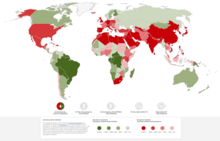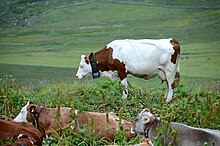Carrying capacity
[9] It had become a staple term in ecology used to define the biological limits of a natural system related to population size in the 1950s.
[8][9] Neo-Malthusians and eugenicists popularised the use of the words to describe the number of people the Earth can support in the 1950s,[9] although American biostatisticians Raymond Pearl and Lowell Reed had already applied it in these terms to human populations in the 1920s.
[citation needed] Hadwen and Palmer (1923) defined carrying capacity as the density of stock that could be grazed for a definite period without damage to the range.
[17] Population size decreases above carrying capacity due to a range of factors depending on the species concerned, but can include insufficient space, food supply, or sunlight.
Carrying capacity is a commonly used concept for biologists when trying to better understand biological populations and the factors which affect them.
[1] When addressing biological populations, carrying capacity can be seen as a stable dynamic equilibrium, taking into account extinction and colonization rates.
Cattle are not all the same, their DSEs can vary depending on breed, growth rates, weights, if it is a cow ('dam'), steer or ox ('bullock' in Australia), and if it weaning, pregnant or 'wet' (i.e. lactating).
Grazing megaherbivores at roughly 1 GV/ha is considered sustainable in central European grasslands, although this varies widely depending on many factors.
In ecology it is theoretically (i.e. cyclic succession, patch dynamics, Megaherbivorenhypothese) taken that a grazing pressure of 0.3 GV/ha by wildlife is enough to hinder afforestation in a natural area.
[citation needed] Some niche market schemes mandate lower stocking rates than can maximally be grazed on a pasture.
[44] The immense technological improvements of the past 100 years—in applied chemistry, physics, computing, genetic engineering, and more—have further increased Earth's human carrying capacity, at least in the short term.
[45] Without the Green Revolution of the 1950s and 60s, famine might have culled large numbers of people in poorer countries during the last three decades of the twentieth century.
Climate change, ocean acidification, and the huge dead zones at the mouths of many of world's great rivers, are a function of the scale of contemporary agriculture[47] and the many other demands 8 billion people make on the planet.
[53][54] This was encapsulated by Paul Ehrlich and James Holdren's (1972) IPAT equation: environmental impact (I) = population (P) x affluence (A) x the technologies used to accommodate human demands (T).
[57] Yet technology has unexpected side effects, as we have seen with stratospheric ozone depletion, excessive nitrogen deposition in the world's rivers and bays, and global climate change.
Additional layers to this for humans are their cultural differences in taste (e.g., some consume flying termites) and individual choices on what to invest their labor into (e.g., fishing vs. farming), both of which vary over time.
These issues show that while there are limits to resources, a more complex model of how humans interact with their ecosystem needs to be used to understand them.
[62]The second of the four main findings is:The changes that have been made to ecosystems have contributed to substantial net gains in human well-being and economic development, but these gains have been achieved at growing costs in the form of the degradation of many ecosystem services, increased risks of nonlinear changes, and the exacerbation of poverty for some groups of people.
“The degradation of ecosystem services could grow significantly worse during the first half of this [21st] century,” they write, serving as a barrier to improving the lives of poor people around the world.
Many biologists, ecologists, and social scientists have disposed of the term altogether due to the generalizations that are made that gloss over the complexity of interactions that take place on the micro and macro level.
Nonetheless, it is possible to not be pessimistic as technological, social, and institutional adaptions could be accelerated, especially in a time of need, to solve problems, or in this case, increase carrying capacity.
[63] Ecological Footprint accounting measures the demands people make on nature and compares them to available supplies, for both individual countries and the world as a whole.
[64] Developed originally by Mathis Wackernagel and William Rees, it has been refined and applied in a variety of contexts over the years by Global Footprint Network (GFN).
Its demand for the goods and services that its land and seas can provide—fruits and vegetables, meat, fish, wood, cotton for clothing, and carbon dioxide absorption—exceeds what the region’s ecosystems can regenerate.
For the rest of the year, we are maintaining our ecological deficit by drawing down local resource stocks and accumulating carbon dioxide in the atmosphere.
[69][64] According to the most recent calculations from Global Footprint Network, most of the world's residents live in countries in ecological overshoot (see the map on the right).
[65] According to its developers, the planetary boundaries framework defines “a safe operating space for humanity based on the intrinsic biophysical processes that regulate the stability of the Earth system.”[49] Human civilization has evolved in the relative stability of the Holocene epoch; crossing planetary boundaries for safe levels of atmospheric carbon, ocean acidity, or one of the other stated boundaries could send the global ecosystem spiraling into novel conditions that are less hospitable to life—possibly reducing global human carrying capacity.
Climate change and biodiversity loss are seen as especially crucial, since on their own, they could push the Earth system out of the Holocene state: “transitions between time periods in Earth history have often been delineated by substantial shifts in climate, the biosphere, or both.” [49] The scientific consensus is that humanity has exceeded three to five of the nine planetary boundaries for safe use of the biosphere and is pressing hard on several more.
[73][74] Population growth regularly tops the list of causes of humanity's increasing impact on the natural environment in Earth system science literature.
[75] Recently, planetary boundaries developer Will Steffen and co-authors ranked global population change as the leading indicator of the influence of socio-economic trends on the functioning of the Earth system in the modern era, post-1750.





